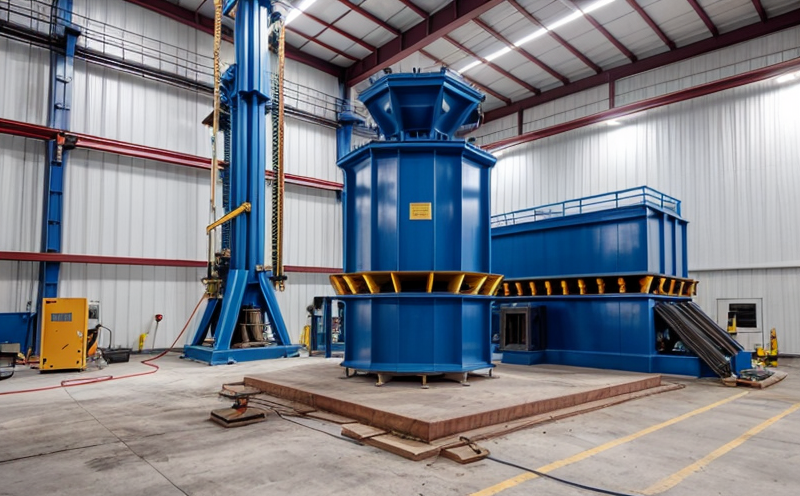ISO 10816-7 Structural Vibration Monitoring and Testing
The ISO 10816 series of standards provides a comprehensive framework for the measurement, evaluation, and control of mechanical vibrations in rotating machinery. Specifically, ISO 10816-7 focuses on structural vibration monitoring and testing, offering detailed guidelines to ensure that machinery operates within acceptable limits, thereby enhancing reliability, safety, and performance.
This standard is widely used across various industries such as automotive, aerospace, manufacturing, and energy generation. The primary goal of ISO 10816-7 is to provide a standardized method for measuring structural vibrations in rotating machinery. This includes the use of accelerometers, displacement sensors, or velocity pickups placed at strategic points on the machine. These sensors capture data which is then analyzed using various techniques including Fast Fourier Transform (FFT) and Time Domain Analysis.
The standard defines clear acceptance criteria based on vibration levels measured in different frequency bands. For example, it specifies limits for accelerations in different zones of the machine during steady-state operation as well as transient conditions like startup or shutdown procedures. Compliance with these standards helps manufacturers ensure that their products meet stringent quality requirements and can operate safely under all expected operating conditions.
One key aspect of ISO 10816-7 is its emphasis on monitoring the machine's behavior over time. Regular inspections allow operators to detect early signs of potential issues before they escalate into more serious problems that could lead to costly repairs or downtime. Additionally, this continuous monitoring can help improve overall maintenance strategies by identifying patterns indicative of particular types of wear and tear.
Another important consideration when implementing ISO 10816-7 is proper installation and calibration of the measurement equipment. Since accurate readings are crucial for reliable assessments, it's essential that all instruments used adhere strictly to manufacturer specifications and undergo regular recalibration according to recommended intervals outlined in relevant documentation.
In addition to technical requirements, ISO 10816-7 also addresses practical aspects like personnel training, data management practices, and record keeping. Proper education ensures technicians understand how best to apply the techniques prescribed by this standard effectively while maintaining consistent quality across multiple locations or facilities.
Environmental and Sustainability Contributions
- The implementation of ISO 10816-7 contributes positively towards sustainability efforts by promoting efficient use of resources through optimized maintenance schedules. By identifying potential issues early, companies can avoid unnecessary replacements and reduce waste associated with unplanned repairs.
- Regular structural vibration monitoring also helps in extending the lifespan of machinery, reducing energy consumption needed for replacement or repair activities. This contributes to lower carbon footprints by minimizing the need for new production runs resulting from premature failure.
- Incorporating ISO 10816-7 into product development processes encourages designers and engineers to consider vibration characteristics early in design stages, leading to more robust and durable products that perform consistently over extended periods without requiring frequent service interventions.
Eurolab Advantages
At Eurolab, our expertise lies in providing comprehensive services that meet the highest international standards. With ISO 10816-7 structural vibration monitoring and testing being one of our key offerings, we leverage advanced technology and experienced personnel to deliver accurate results every time.
We employ state-of-the-art instrumentation capable of capturing precise data points necessary for thorough analysis according to the specified criteria laid out in ISO 10816-7. Our team comprises professionals who are thoroughly trained not only on how to operate this equipment but also understand its implications within broader contexts such as safety, environmental impact, and operational efficiency.
Our commitment extends beyond just performing tests; we offer valuable insights based on our findings that help clients make informed decisions regarding their machinery's performance. Whether it’s identifying areas needing improvement or validating existing processes against industry benchmarks, Eurolab ensures each client receives actionable recommendations tailored specifically to their needs and goals.
Moreover, our dedication to continuous improvement means we stay updated with any changes in best practices or new developments within the field of structural vibration monitoring. This allows us to provide clients with cutting-edge solutions that not only comply with current standards but also anticipate future trends.
Customer Impact and Satisfaction
Our customers benefit significantly from our ISO 10816-7 structural vibration monitoring and testing services. By leveraging these tests, they gain deeper insights into their machinery's condition which enables them to take proactive measures that enhance reliability and extend equipment life.
Proactive maintenance strategies informed by accurate test results contribute directly to reduced downtime, lower operational costs, and improved productivity levels. Our clients report higher satisfaction rates because our services provide clear evidence supporting decisions made during the lifecycle of their assets.
We pride ourselves on delivering high-quality reports that are easy to understand yet comprehensive enough to cover all relevant aspects discussed in ISO 10816-7. These documents serve as valuable reference materials for internal teams responsible for managing maintenance schedules, planning upgrades, or justifying investments related to equipment purchases.
Furthermore, by partnering with Eurolab for these tests, customers demonstrate their commitment to adhering to international best practices which enhances their reputation among stakeholders including investors, regulators, and end-users.





